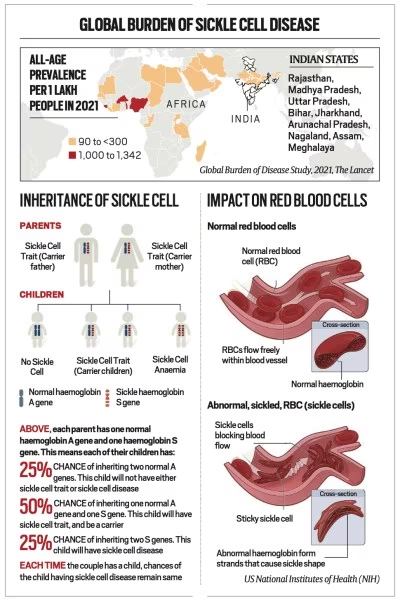Important Facts For Prelims
Casgevy Therapy for Sickle Cell Disease and Thalassaemia
- 30 Nov 2023
- 6 min read
Why in News?
Recently, the UK Drug Regulator sanctioned a gene therapy called Casgevy heralded as a significant breakthrough for treating sickle cell disease and thalassaemia.
- Notably, this marks the world's inaugural licensed therapy leveraging the CRISPR-Cas9 gene editing technology that earned its innovators a Nobel Prize in Chemistry 2020.
How does the Casgevy Therapy Work?
- Both sickle cell disease and thalassaemia are caused by errors in the gene for haemoglobin(Hb), a protein in the red blood cells that carry oxygen to organs and tissues.
- The therapy uses the patient’s own blood stem cells, which are precisely edited using CRISPR-Cas9.
- A gene called BCL11A, which is crucial for switching from foetal to adult haemoglobin, is targeted by the therapy.
- Foetal haemoglobin, which is naturally present in everyone at birth, does not carry the same abnormalities as adult haemoglobin.
- The therapy uses the body’s own mechanisms to start producing more of this foetal haemoglobin, alleviating the symptoms of the two conditions.
- Casgevy involves a single treatment wherein blood stem cells are extracted via apheresis and then edited over approximately six months before being reintroduced into the patient.
- Apheresis is a medical procedure that involves removing specific components from blood and returning the rest to the body.
What are Sickle Cell Disease and Thalassaemia?
- Sickle Cell Disease:
- About: Sickle cell disease is a genetic blood disorder characterized by an abnormality in hemoglobin, the protein responsible for carrying oxygen in red blood cells.
- It causes red blood cells to adopt a sickle or crescent shape, hindering their movement through vessels, leading to potential complications like severe pain, infections, anaemia, and strokes.
- In India alone, an estimated 30,000-40,000 children are born with sickle cell disease annually.
- Types: It encompasses various types, each dependent on the inherited genes from parents, all encoding abnormal hemoglobin. The most prevalent forms of SCD include:
- HbSS (Sickle Cell Anemia): Individuals inherit two "S" genes, one from each parent, resulting in abnormal hemoglobin "S."
- This type often leads to severe manifestations characterized by rigid, sickle-shaped red blood cells.
- HbSC: Inheriting an "S" gene from one parent and a different abnormal hemoglobin, "C," from the other, leads to this milder variant of SCD.
- HbS Beta Thalassemia: This form arises from inheriting an "S" gene from one parent and a beta thalassemia gene from the other.
- The severity varies based on the type of beta thalassemia inherited either "zero" (HbS beta0) or "plus" (HbS beta+), with the former typically resulting in a severe form and the latter in a milder manifestation.
- HbSS (Sickle Cell Anemia): Individuals inherit two "S" genes, one from each parent, resulting in abnormal hemoglobin "S."
- About: Sickle cell disease is a genetic blood disorder characterized by an abnormality in hemoglobin, the protein responsible for carrying oxygen in red blood cells.
- Thalassaemia: Similar to sickle cell disease, individuals with thalassaemia experience severe anaemia due to low haemoglobin levels, necessitating lifelong blood transfusions and chelation therapy to manage iron accumulation.
- Major symptoms include fatigue, paleness or jaundice, shortness of breath, delayed growth, facial bone deformities (in severe cases) among others.
Note
Chelation therapy is a proven treatment for heavy metal poisoning. It uses substances that bind to heavy metals and help clear them from the body.
Note
The National Sickle Cell Anemia Eradication Mission in India targets the elimination of sickle cell anemia by 2047.
What is CRISPR-Cas9 Technology?
- CRISPR-Cas9 is a groundbreaking technology that empowers geneticists and medical researchers to modify specific portions of the genome.
- This is achieved through the precise removal, addition, or modification of segments within the DNA sequence.
- It involves two essential parts for editing DNA. First, there is Cas9, which acts like molecular scissors, cutting DNA at specific spots.
- Then, there is guide RNA (gRNA), containing a designed sequence. This sequence guides Cas9 to the exact spot in the genome to make the cut.
- This precise guidance ensures Cas9 works accurately where needed, allowing for specific changes in the DNA.
UPSC Civil Services Examination, Previous Year Question (PYQ)
Prelims
Q. What is Cas9 protein that is often mentioned in news? (2019)
(a) A molecular scissors used in targeted gene editing
(b) A biosensor used in the accurate detection of pathogens in patients
(c) A gene that makes plants pest-resistant
(d) A herbicidal substance synthesized in genetically modified crops
Ans: (a)
Mains
Q. What are the research and developmental achievements in applied biotechnology? How will these achievements help to uplift the poorer sections of society? (2021)







